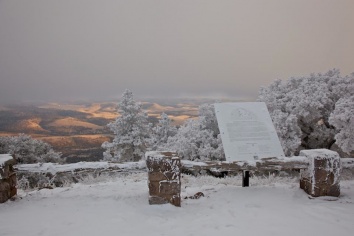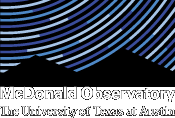The Weather at the Observatory
Temperatures vary quite a bit at our elevation (6,300-6,800 feet above sea level) and are usually much cooler than other areas of Texas. For summer make sure you bring a light jacket and long pants. For Fall, Winter, and early Spring programs, layer your attire and bring a warm coat, thermals, gloves, and something to keep your head warm.
Some useful weather links to help plan your visit to the Observatory:
- National Weather Service forecast for the Observatory,
- The Weather Underground forecast,
- the National Center for Atmospheric Research satellite view (choose "ABQ" on the map for our area),
- AccuWeather Astronomy Forecast, and
- Intellicast radar (enter "Fort Davis, TX" for our area).
Monthly climate data, 1935-2012, are listed below. Please note that low and high temperatures (Fahrenheit) are averages; therefore, the low temperature on a particular night can be much lower (20's or teens in winter for example):
| Month | Avg High | Record High | Avg Low | Record Low | Avg Rain (in) | Avg Snow (in) |
| Jan | 54 | 80 | 32 | -10 | 0.68 | 1.9 |
| Feb | 57 | 79 | 34 | -6 | 0.49 | 0.8 |
| Mar | 64 | 88 | 38 | 4 | 0.4 | 0.2 |
| Apr | 71 | 94 | 45 | 11 | 0.5 | 0.1 |
| May | 79 | 96 | 52 | 26 | 1.63 | 0 |
| Jun | 85 | 104 | 58 | 36 | 2.49 | 0 |
| Jul | 83 | 100 | 59 | 40 | 3.82 | 0 |
| Aug | 81 | 104 | 58 | 40 | 3.69 | 0 |
| Sep | 77 | 96 | 54 | 29 | 2.95 | 0 |
| Oct | 71 | 94 | 48 | 13 | 1.61 | 0.1 |
| Nov | 61 | 82 | 39 | 8 | 0.61 | 0.4 |
| Dec | 54 | 80 | 34 | -2 | 0.6 | 1.2 |
Source: Western Regional Climate Center
Visitors Center weather station current conditions:

A view of the valley outside of Fort Davis from the top of Mount Locke on December 24th, 2011. Note that, while the valley floor was free of snow, Mt. Locke was mostly frozen over. Temperatures at the Observatory are frequently 10 or more degrees (F) lower than the surrounding areas. (Frank Cianciolo / McDonald Observatory)

